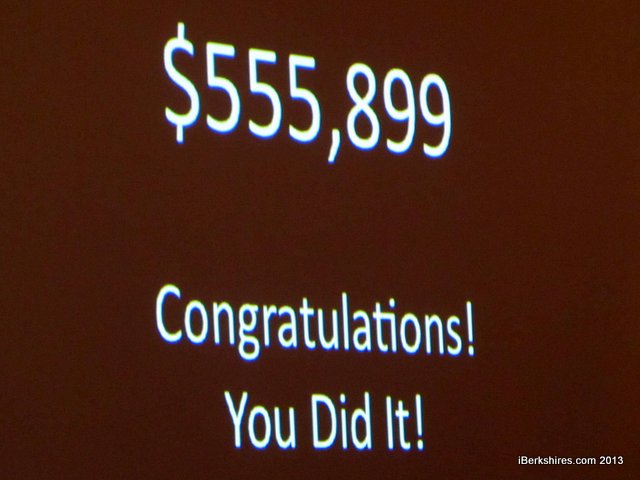Northern Berkshire United Way Exceeds 2013 Campaign Goal



NORTH ADAMS, Mass. — The North Berkshire United Way marked a milestone on Thursday by exceeding its annual campaign goal for the first time in five years.
This year's campaign Chairmen Osmin F. Alvarez, president and CEO of Boxcar Media LLC and publisher of iBerkshires.com, and Robert G. Abel, president and CEO of True North Financial Services, were so confident that they'd reach the $550,000 goal they read their victory speech last September.
They were right: The final tally is $555,899
"Big things can happen when a lot of people give a little," said Abel, addressing the nearly 200 United Way supporters and representatives of the organizations the agency serves at the annual breakfast at the Williams Inn. "The generosity we have seen from all of you, your employees and so many others throughout our community has been impressive."
Northern Berkshire United Way has been struggling to reach its annual goal since the economic collapse in 2008. The drive is a major fundraiser for the United Way and its member agencies.
NBUW Chairman Thomas Rumboldt compared the past five years to the Red Sox gameball he'd dropped and had to scramble after at Fenway Park.
"This ball isn't just a ball," he said, pulling it out of his pocket. "This is a symbol of perseverance, it's a goal of not giving up. ... Five years ago, we had a ball hit to us, the Northern Berkshire United Way. ... We didn't give up on that ball. We've been under the seats for the past five years trying to grab it."
This year's campaign was certainly reflective of a recovering economy but also the drive of the two chairmen in their first times in the role.
But over the last nine months, the friendly competition between Abel and Alverez that had launched the drive (NBUW Executive Director Joseph McGovern joshed that "there is no adjective in any dictionary for how competitive these two guys are.") came to focus more on the people and services that the United Way supports.
 Thomas Rumboldt and his symbol of 'perseverance.' Thomas Rumboldt and his symbol of 'perseverance.' |
It wasn't the goal, said Alvarez, but the journey that was "eye-opening, fulfilling, humbling and truly inspiring."
"The journey showed us how lucky we are to live in a community that has such caring, dedicated and selfless members," he said. "The journey was more fulfilling and educational than any goal could ever be."
So instead of announcing the drive's total with the grand flourish, the gathering was treated to a video showing some of the people who will benefit from the funds raised — from senior citizens to preschoolers — all holding handmade signs with adjectives found in the dictionary: awesome, great, super, etc.
McGovern said he could see the change in focus as the chairmen met with the agencies and people under the United Way umbrella.
"It was no longer about the goal, it was raising as much money possible to help the agencies make a difference in our community," he said. "It was uplifting to see how many people approached either myself or the guest speaker at employee campaign rallies to tell stories of how their sister, their mother, their father and their neighbor was getting support from one or more of our member agencies."
The Northern Berkshire United Way supports more than 20 agencies in North County, providing services ranging from health care to legal services to mental health services to more than 11,000 residents.
Partners like NBUW will become more important as the federal Affordable Care Act is implemented, said guest speaker Timothy Jones, president and CEO of Northern Berkshire Healthcare.
 Guest speaker Tim Jones of Northern Berkshire Healthcare said the health system will be looking to partner with NBUW and its agencies as the way health-care is delivered changes. Guest speaker Tim Jones of Northern Berkshire Healthcare said the health system will be looking to partner with NBUW and its agencies as the way health-care is delivered changes. |
Jones said, from his perspective, health-care reform could be boiled down to two things: access and funding. While the reform will open up access to millions, how to pay for it is still being worked out. Hospitals and health institutions have to become more efficient in providing quality care to control costs, which North Adams Regional is doing by using the Toyota system of "lean production" in eliminating wasteful practices and processes.
"We have to get there. If we don't get there, we're going to be in significant trouble," said Jones. "Everyone in this room knows where this organization has been. There's no do-overs in this world, we can't go through that process again."
So in addition in implementing efficencies, the hospital will be looking to ally with organizations "outside the box" from the usual health care institutions. United Way is an obvious partner.
"Our vision is being a vital partner in creating more sustainable and healthier communities," said Jones. "That's our vision because in the new health-care world, it's not about treating sick patients, it's about helping create healthier communities."
Tags: breakfast, fundraiser, NBUW,















